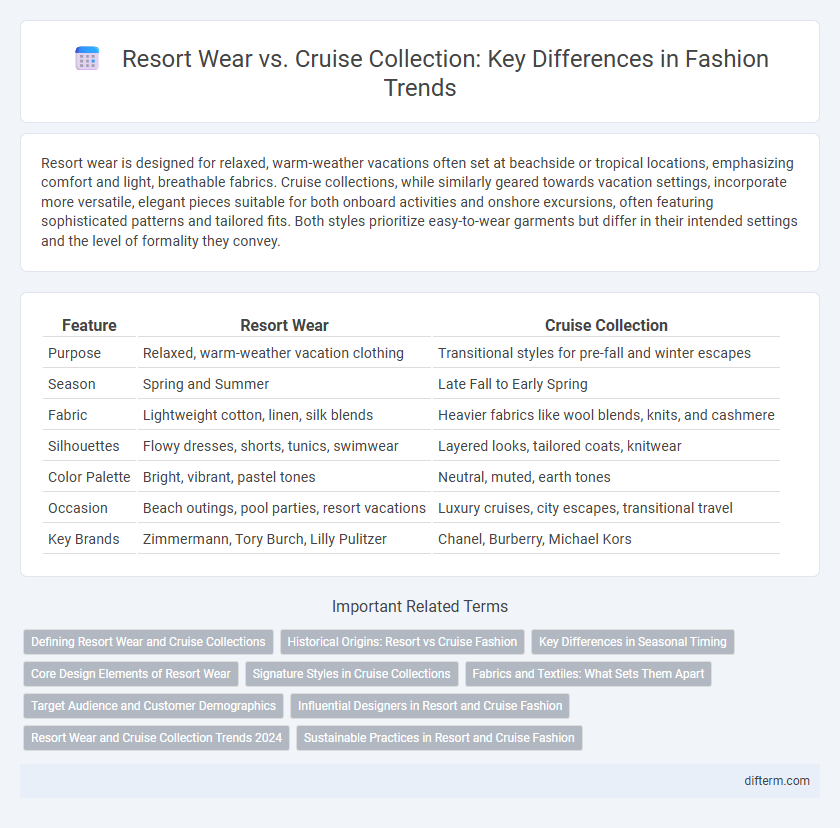Resort wear is designed for relaxed, warm-weather vacations often set at beachside or tropical locations, emphasizing comfort and light, breathable fabrics. Cruise collections, while similarly geared towards vacation settings, incorporate more versatile, elegant pieces suitable for both onboard activities and onshore excursions, often featuring sophisticated patterns and tailored fits. Both styles prioritize easy-to-wear garments but differ in their intended settings and the level of formality they convey.
Table of Comparison
| Feature | Resort Wear | Cruise Collection |
|---|---|---|
| Purpose | Relaxed, warm-weather vacation clothing | Transitional styles for pre-fall and winter escapes |
| Season | Spring and Summer | Late Fall to Early Spring |
| Fabric | Lightweight cotton, linen, silk blends | Heavier fabrics like wool blends, knits, and cashmere |
| Silhouettes | Flowy dresses, shorts, tunics, swimwear | Layered looks, tailored coats, knitwear |
| Color Palette | Bright, vibrant, pastel tones | Neutral, muted, earth tones |
| Occasion | Beach outings, pool parties, resort vacations | Luxury cruises, city escapes, transitional travel |
| Key Brands | Zimmermann, Tory Burch, Lilly Pulitzer | Chanel, Burberry, Michael Kors |
Defining Resort Wear and Cruise Collections
Resort wear typically encompasses lightweight, versatile clothing designed for warm climates, featuring breathable fabrics like linen and cotton, perfect for beach vacations and casual luxury settings. Cruise collections focus on sophisticated, travel-centric pieces that balance comfort and elegance, often including chic separates and statement accessories suited for on-board activities and port excursions. Both styles prioritize adaptability and ease, but resort wear leans more towards relaxed daytime attire while cruise collections offer a polished transition from daywear to evening events.
Historical Origins: Resort vs Cruise Fashion
Resort wear originated in the early 20th century as clothing designed for wealthy travelers visiting warm, tropical destinations during the winter months, emphasizing comfort and lightweight fabrics like linen and silk. Cruise collections, emerging later, evolved from this concept to include more versatile, stylish ensembles suited for a variety of vacation settings, blending casual elegance with nautical influences. Both styles share historical roots in leisure travel but differ in their seasonal focus and design elements reflecting shifting fashion trends across decades.
Key Differences in Seasonal Timing
Resort wear is designed for warm-weather vacations typically during the winter months, offering lightweight fabrics and breathable silhouettes ideal for escapes to tropical destinations. Cruise collections target the late fall to early winter season, aligning with cruise ship itineraries and featuring versatile pieces that transition smoothly from day excursions to evening events on board. While both emphasize comfort and style, resort wear leans toward relaxed, sun-ready attire, whereas cruise collections often incorporate more polished, sophisticated elements for varied social settings.
Core Design Elements of Resort Wear
Resort wear features lightweight fabrics such as linen and cotton that prioritize breathability and comfort for warm climates. Signature design elements include loose silhouettes, vibrant prints inspired by tropical themes, and versatile pieces like kaftans, palazzo pants, and sundresses. The emphasis on easy layering and sun protection distinguishes resort wear from cruise collections, which often highlight more formal and sea-inspired styles.
Signature Styles in Cruise Collections
Signature styles in cruise collections emphasize versatile, luxurious fabrics and sophisticated designs ideal for transitional seasons, blending resort wear's relaxed elegance with tailored silhouettes. Key elements include lightweight knits, structured blazers, and chic separates that effortlessly shift from daytime excursions to evening events. These collections prioritize timeless patterns, such as nautical stripes and tropical prints, enhancing both comfort and glamour for jet-set travelers.
Fabrics and Textiles: What Sets Them Apart
Resort wear typically features lightweight, breathable fabrics such as cotton, linen, and chambray, designed for warm-weather comfort and casual elegance. Cruise collections often incorporate more structured textiles like silk blends and fine knits, balancing luxury with versatility suitable for varied climates. The distinct choice of fabrics in each collection highlights their unique functional and stylistic purposes within fashion.
Target Audience and Customer Demographics
Resort wear typically targets affluent travelers seeking stylish comfort for beach vacations, featuring lightweight fabrics and vibrant prints appealing to women aged 25-45 with a high disposable income. Cruise collections cater to a broader demographic, including families and older adults aged 40-65, offering versatile pieces that balance elegance and practicality for onboard events and excursions. Both styles prioritize premium materials and trend-conscious designs but differ in age range and lifestyle preferences within the luxury leisure market.
Influential Designers in Resort and Cruise Fashion
Influential designers in resort and cruise fashion, such as Michael Kors, Tory Burch, and Chanel's Virginie Viard, have redefined luxury vacation wardrobes with versatile, stylish pieces that blend comfort and elegance. Their resort and cruise collections emphasize lightweight fabrics, bold prints, and sophisticated silhouettes designed for warm-weather destinations, making these lines essential for affluent travelers. These designers consistently shape trends that elevate resort and cruise wear from seasonal offerings to year-round wardrobe staples.
Resort Wear and Cruise Collection Trends 2024
Resort wear in 2024 emphasizes lightweight fabrics, bold tropical prints, and versatile silhouettes designed for warm-weather destinations, reflecting a fusion of comfort and elegance. Cruise collections focus on refined tailoring, nautical-inspired details, and sustainable materials, catering to travelers seeking both style and eco-conscious options. Key trends include pastel hues, breathable linens, and statement accessories that seamlessly transition from daytime beach outings to evening social events.
Sustainable Practices in Resort and Cruise Fashion
Resort wear and cruise collections increasingly prioritize sustainable practices by incorporating eco-friendly materials such as organic cotton, recycled polyester, and biodegradable fabrics. Brands emphasize ethical production methods, reducing water consumption and carbon footprints throughout the supply chain. This shift not only supports environmental responsibility but also aligns with consumer demand for transparent and sustainable fashion in vacation wardrobes.
resort wear vs cruise collection Infographic

 difterm.com
difterm.com